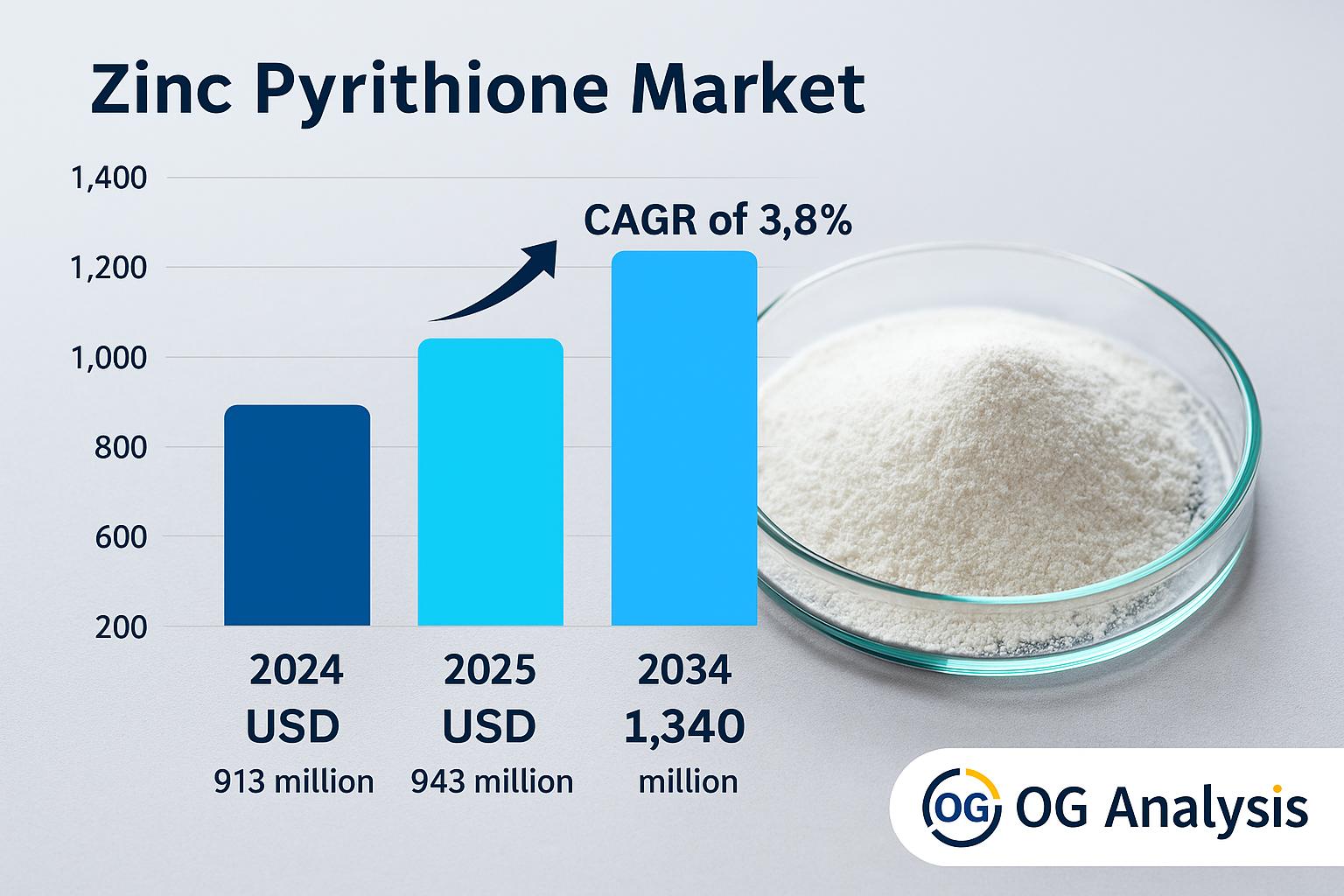Is Zinc Pyrithione the Unsung Hero of Modern Formulations?
Known for its antifungal and antibacterial properties, zinc pyrithione has long been a staple in cosmetics, personal care, and coatings. But as consumers demand more performance from less—and regulations challenge product safety profiles—zinc pyrithione is finding new relevance in evolving industrial and pharmaceutical applications. According to OG Analysis, the Global Zinc Pyrithione Market was valued at USD 913 million in 2024 and is projected to reach USD 943 million in 2025, expanding at a CAGR of 3.8% to reach USD 1,340 million by 2034.
1. Why Is Zinc Pyrithione Making a Comeback Across Personal and Industrial Formulations?
In a post-pandemic world where hygiene, skin health, and surface protection are prioritized, zinc pyrithione’s ability to inhibit microbial growth is more relevant than ever. From anti-dandruff shampoos to antifouling paints and pharmaceutical topical treatments, the compound is being re-evaluated for its effectiveness, safety, and versatility—especially in regions pushing for multi-functional active ingredients.

2. What Are the Key Applications Powering Demand Across End-Use Industries?
- Cosmetics and Personal Care remain the dominant sector, particularly in scalp-care, acne treatments, and antibacterial cleansers.
- Paint and coatings manufacturers use zinc pyrithione to prevent mildew and mold on architectural surfaces.
- Pharmaceutical and biocide segments are expanding its use in dermatology creams, foot sprays, and disinfectants.
This wide applicability is helping the product transcend seasonal use and achieve year-round demand across markets.
3. Which Form and Grade Are Industry Favorites—and Why?
- Pharmaceutical Grade zinc pyrithione is rising in demand due to the increase in clinical formulations and medical-grade skincare.
- Industrial Grade is dominant in paints, coatings, and preservatives, offering cost-effective performance.
- Powder Form is preferred in solid and semi-solid products like soaps and tablets, while liquid form is common in sprays, shampoos, and emulsions.
As brands focus on formulation flexibility and cost-to-performance ratio, the demand for tailored grades and formats is driving product diversification.
Click Here for the Full Market Report:
4. How Are Leading Players Innovating to Stay Competitive?
Companies like AkzoNobel, BASF, Clariant, and Kumar Organic Products are:
- Enhancing purity levels to meet stricter regulatory demands
- Developing low-residue, high-efficiency variants
- Exploring synergistic combinations with other antimicrobials
- Expanding into eco-friendly production methods
Such efforts aim to balance efficacy with environmental compliance, a major consideration in the evolving global regulatory landscape.
5. What Regional Markets Are Driving and Reshaping Global Dynamics?
- Asia-Pacific, especially China, India, and Japan, dominates due to strong cosmetics manufacturing, population-driven personal care demand, and cost-effective production.
- Europe emphasizes regulatory safety and sustainable formulations, with growth in pharma-grade biocides.
- North America shows steady demand in over-the-counter (OTC) dermatological products and industrial surface coatings.
- Latin America and the Middle East are emerging, especially in the paints and agriculture-related preservatives sector.
Global players are increasingly localizing their offerings to suit regional consumer preferences and regulatory norms.
6. What Are the Growth Opportunities Emerging Post-2025?
- Rising demand for safe scalp care products in men’s grooming
- Growth in medical-grade disinfectants and antifungal treatments due to global health awareness
- Eco-label innovations—reformulating zinc pyrithione with biodegradable or hybrid carriers
- Industrial coatings in construction and marine applications gaining interest in antifungal paints
Each trend contributes to a more resilient and diversified market outlook.
7. How Will Regulatory Shifts Impact Market Trajectory?
Zinc pyrithione has faced scrutiny in some regions due to its toxicity at high exposure levels, especially in leave-on applications. However, continued use in rinse-off formulations (such as shampoos) is permitted across major markets. Companies that adapt to safer concentrations, improve safety documentation, and invest in alternative applications will turn compliance into competitive advantage.
Click Here for the Full Market Report:
Key Segments of the Zinc Pyrithione Market Driving Opportunities and Innovations
By Application:
Cosmetic and Personal Care
Paint and Coatings
Pharmaceuticals
Biocides
Others
By Grade:
Industrial Grade
Pharmaceutical Grade
By Form:
Liquid Form
Powder Form
By Geography:
North America (USA, Canada, Mexico)
Europe (Germany, UK, France, Spain, Italy, Rest of Europe)
Asia-Pacific (China, India, Japan, Australia, Rest of APAC)
The Middle East and Africa (Middle East, Africa)
South and Central America (Brazil, Argentina, Rest of SCA)
Browse through More Reports Similar to the Zinc Pyrithione Market 2025, By OG Analysis:
Global Paints and Coatings Additives Market Outlook Report:
Hydrophilic Coatings Market outlook Report:
Connect with us on:
Phone: +91 888 64 99099
Email: mailto:sales@oganalysis.com